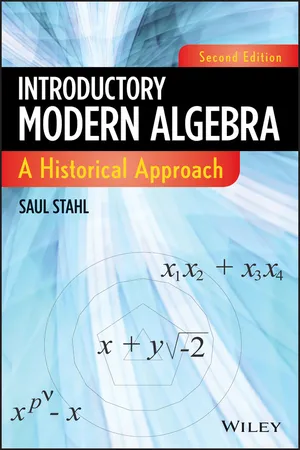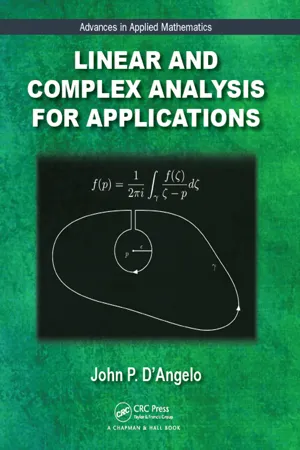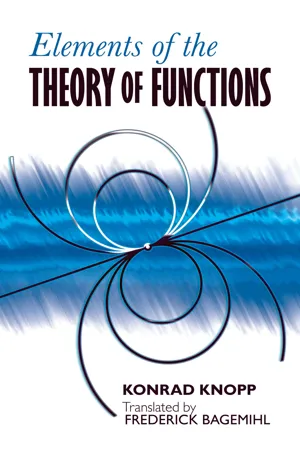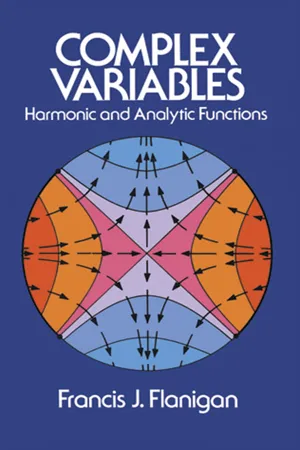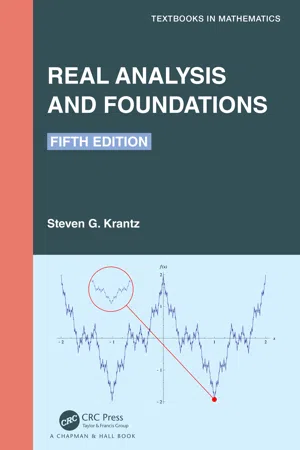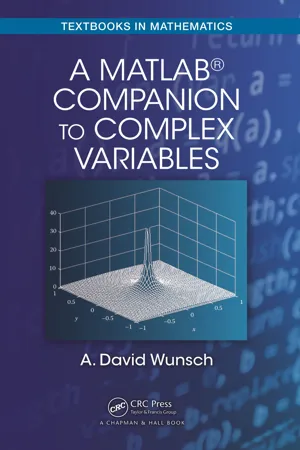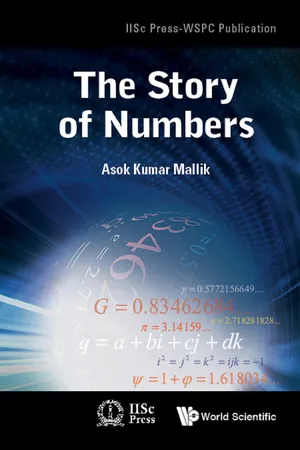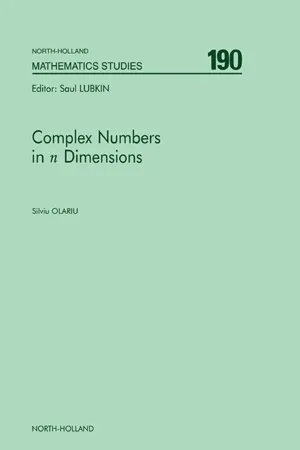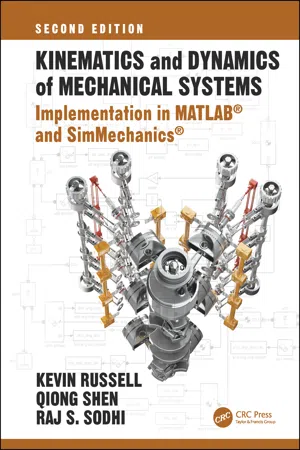Mathematics
Operation with Complex Numbers
Operations with complex numbers involve addition, subtraction, multiplication, and division of numbers in the form a + bi, where "a" and "b" are real numbers and "i" is the imaginary unit. Addition and subtraction are performed by combining the real and imaginary parts separately, while multiplication and division are carried out using the properties of the imaginary unit "i."
Written by Perlego with AI-assistance
Related key terms
Related key terms
1 of 4
Related key terms
1 of 3
11 Key excerpts on "Operation with Complex Numbers"
- eBook - ePub
Introductory Modern Algebra
A Historical Approach
- Saul Stahl(Author)
- 2013(Publication Date)
- Wiley(Publisher)
real. These complex numbers can be added and subtracted as polynomials. Thus,The multiplication of complex numbers also resembles that of polynomials, except that each occurrence of i2 is replaced by −1. Thus,The division of complex numbers mimics the well-known process of rationalizing denominators. Thus,Surprisingly, all of these arithmetical operations can be given very interesting visual, or geometric, interpretations. To accomplish this, we represent each complex number a + bi by the point (a, b) of the Cartesian plane. The point (a, b) is called the Cartesian representation of the complex number a + bi. Given two complex numbers a + bi and c + di, let their Cartesian representations be P = (a, b) and Q = (c, d) (Figure 2.1 ). Their sumFigure 2.1Complex additionis represented by the point R = (a + c, b + d). However,andConsequently, PR || OQ and QR || OP and so OPRQ is a parallelogram. Thus we see that the addition of complex numbers resembles that of vectors. These considerations are summarized as follows.Proposition 2.1 Let O denote the origin of the Cartesian plane and let P and Q be the Cartesian representations of the complex numbers a + bi and c + di, respectively. If the sum of the two complex numbers is represented by the point R, then the quadrilateral OPRQ is a parallelogram.To give the multiplication of complex numbers a visual interpretation, it is convenient to begin by establishing some conventions. In the sequel, the general complex number a + bi will frequently be abbreviated as z. If either a or b is 0, it is omitted from a + b - eBook - ePub
- John P. D'Angelo(Author)
- 2017(Publication Date)
- CRC Press(Publisher)
CHAPTER 2 Complex numbers The extent to which complex numbers arise in physics and engineering is almost beyond belief. We start by defining the complex number field ℂ. Since ℂ is a field, in the rest of the book we can and will consider complex vector spaces. In this chapter, however, we focus on the geometric and algebraic properties of the complex numbers themselves. One of the main points is the relationship between the complex exponential function and the trig functions. 1. Basic definitions A complex number is a pair (x, y) of real numbers, or simply the point (x, y) in ℝ 2. By regarding this pair as a single object and introducing appropriate definitions of addition and multiplication, remarkable simplifications arise. As sets, we have ℂ = ℝ 2. We add componentwise as usual, but we introduce a definition of multiplication which has profound consequences. Figures 1 and 2 provide geometric intuition. (x, y) + (a, b) = (x + a, y + b) (1) (x, y) * (a, b) = (x a – y b, x b + y a). (2) The idea behind formula (2) comes from seeking a square root of –1. Write (x, y) = x + iy and (a, b) = a + ib. If we assume the distributive law is valid, then we get (x + i y) (a + i b) = x a + i 2 y b + i (x b + y a). (3) If we further assume in (3) that i 2 = –1, then we get (x + i y) (a + i b) = x a – y b + i (x b + y a) (4) This result agrees with (2). Why do we start with (2) rather than with (4)? The answer is somewhat philosophical. If we start with (2), then we have not presumed the existence of an object whose square is –1. Nonetheless, such an object exists, because (0,1) ∗ (0, 1) = (–1, 0) = –(1, 0). Therefore no unwarranted assumptions have been made. If we started with (4), then one could question whether the number i exists. Henceforth we will use the complex notation, writing (x, y) = x + iy and (a, b) = a + ib. Then (x + i y) + (a + i b) = x + a + i (y + b) (x + i y) (a + i b) = x a – y b + i (x b + y a). Put z = x + iy - eBook - ePub
- Konrad Knopp, Bagemihl, Frederick, Bagemihl, Frederick(Authors)
- 2016(Publication Date)
- Dover Publications(Publisher)
IV, 6 must be modified in the manner agreed upon.As the simplest examples, we stress, above all, the operation with powers and the validity of the binomial theorem: If a is an arbitrary complex number, and n is a natural number, then the product of n factors, all equal to a, is denoted, as in the real domain, by an . And the same considerations as there lead one, in case the base a ≠ 0, to understand by a0 the number 1, and by a– n the value 1/an . According to these stipulations, the power ak is defined for every integral exponent k, and for operating with these powers we have the three ruleswhere the base 0 may appear only if the exponent is positive.If a and b are two arbitrary complex numbers, and if n is a natural number, thenThe fundamental operations addition, subtraction, multiplication, and division are named the four rational operations. If division is excluded, we speak of the integral rational operations. An expression which (as, e.g., the preceding one) is formed from any literal quantities and numbers by applying the rational operations (a finite number of times) is therefore called a rational expression, and, in particular, an integral rational expression, if only the integral rational operations are employed.10. The system of complex numbers as an extension of the system of real numbersOn the basis of the historical development, which is reflected in the terminology introduced in §5 , it has been regarded as a foregone conclusion that the system of complex numbers is an extension of the system of real numbers. We have as yet to clarify the extent to which this is the case. For, pairs of real numbers are not themselves real numbers. Every number pair (α, 0), however, whose second coordinate is equal to 0, whose representative point consequently lies on the “axis of reals,” appears, nevertheless, to be actually a real number in a certain sense. What does this mean? Just this: If every number pair (α, 0) is written in abbreviated form simply as α, then one verifies immediately, that every calculation which proceeds according to the rules laid down for operating with number pairs, and which employs number pairs exclusively of the form (α, 0), goes over into a correct calculation with real numbers. In fact, equality, sum, and product of two such pairs (α, 0) and (β, 0) thereby go over, respectively, into equality, sum, and product of α and β; and that suffices. This is expressed by saying: The subsystem of all number pairs (α, 0) is isomorphic - eBook - ePub
- Francis J. Flanigan(Author)
- 2013(Publication Date)
- Dover Publications(Publisher)
3Complex Numbers andComplex Functions
Section 3.1 THE COMPLEX NUMBERS
3.1.0 Introduction
In this section we construct the set of complex numbers, identifying each such number with a point in the plane 2 . This amounts to endowing the plane with a multiplication as well as an addition. This multiplication is of profound importance for later developments, as we shall see.3.1.1 Basic Definitions
Let denote the set of all elements z of the formwhere x, y and i is a symbol, to be interpreted below (it is not a real number). If y = 0, then we write z = x .It follows from our definition thatare equal as elements of if and only ifNote that here we continue to let x, y , , denote real numbers. One complex equation gives two real equations.Some examples: 2 + 3i , + 5i , 0 + i (usually writteni), + (−5)i (usually written − 5i ), 3 + 0i = 3, 0 + 0i = 0.Addition and Subtraction
If z = x + yi and = +iare in , then we define their sum and difference , respectively, to beand note that these are also in .Multiplication
We know how to multiply two real numbers. Let us agree to multiply the symbol i as follows:(very important), and also for a and b real,To multiply z = x + yi by = +i, we repeatedly apply these rules by means of a “distributive law.” Thus,since i 2 = −1. Thus, the product of two elements of is again an element of . Note that z = z always, just as in .For example, (2 + 3i ) (−1 + 5i ) = −17 + 7i (check it!).Complex Numbers
The set with addition and multiplication thus defined is called the set of complex numbers , and each z = x + yi is a complex number.Since we write x + 0i simply as x , the set of real numbers may be thought of as a subset of the set of complex numbers, . Note thatso that real multiplication and the newly defined complex multiplication are compatible.Zero: We have 0 = 0 + 0i . Note that, for all z ∈ ,More on i: The complex number i is not real, but its square −1 is. It is standard to write , the “square root of minus one.” We recall that only nonnegative real numbers have real square roots. The letter i may stand for “imaginary.” If z = x + iy , then x and y are the real (Re) and imaginary (Im) parts of z - eBook - ePub
- Jamal T. Manassah(Author)
- 2017(Publication Date)
- CRC Press(Publisher)
6 Complex NumbersIn this chapter, we start by reviewing the basic algebraic and geometrical properties of complex numbers; we then proceed to show the power of complex numbers as tools for solving a number of basic electrical engineering problems.6.1 Introduction
Since x 2 > 0 for all real numbers x, the equation x 2 =−1 admits no real number as a solution. To deal with this problem, mathematicians in the eighteenth century introduced the imaginary numberExpressions of the formi =. (So as not to confuse the usual symbol for a current with this quantity, electrical engineers prefer the use of the j symbol. MATLAB accepts either symbol, but always gives the answer with the symbol i .)− 1= jz = a + j b( 6.1 )where a and b are real numbers, are called complex numbers. As illustrated in Section 6.2 , this representation has properties similar to that of an ordered pair (a , b ), which is represented by a point in the 2-D plane.The real number a is called the real part of z , and the real number b is called the imaginary part of z . These numbers are referred to by the symbols a = Re(z ) and b = Im(z ).When complex numbers are represented geometrically in the x −y coordinate system, the x -axis is called the real axis, the y -axis is called the imaginary axis, and the plane is called the complex plane.6.2 The Basics
In this section, you will learn how, using MATLAB, you can represent a complex number in the complex plane. It also shows how the addition (or subtraction) of two complex numbers, or the multiplication of a complex number by a real number or by j - eBook - ePub
Mechanical Vibration
Analysis, Uncertainties, and Control, Fourth Edition
- Haym Benaroya, Mark Nagurka, Seon Han(Authors)
- 2017(Publication Date)
- CRC Press(Publisher)
Appendix AMathematical Concepts for Vibration
“We are reminded of the essential rules .”This appendix presents mathematical concepts that may be helpful to those studying vibration. It is not meant to be a substitute for courses covering linear algebra, calculus, and differential equations. We assume that the reader has had some experience with the topics.A.1 Complex NumbersA complex number z = x + iy is the sum of a real part x and an imaginary part iy , with x and y both real and. The complex conjugate of z is x - iy . Complex numbers, which arise in many scientific disciplines, are needed in the general solution polynomial equations, including of quadratic equations. Before the 18th century, complex numbers and the square root of minus one were in regular use.i =- 11The equation2e=i θcosθ + isinθis credited to Euler and is known as Euler ’s formula .A.1.1 Complex Number OperationsTwo complex numbers are added or subtracted by simply adding or subtracting their corresponding real and imaginary parts. For example, the sum of 8 + 3i and 6 + 3i is 14 + 6i .Complex number multiplication is similar to real number multiplication. For example,( x + i y ) ( u + i v ) = ( x u - y v ) + i ( x v + y u ) .In division of complex numbers, the convention is to express the fraction such that there is no imaginary part in the denominator. This can be accomplished by multiplying the numerator and denominator of the complex fraction by the complex conjugate of the denominator u - iv to find(A.1)=x + i yu + i v( x u + y v ) + i ( - x v + y u )u 2+v 2Example A.l Rewrite the complex fractioninto its real and imaginary parts.1 - 2 i7 + 3 iSolution: - eBook - ePub
- Steven G. Krantz(Author)
- 2022(Publication Date)
- Chapman and Hall/CRC(Publisher)
These assertions are explored more thoroughly in the exercises. With the remarks in the preceding paragraph, we can sometimes ignore the distinction between the real numbers and the complex numbers. For example, we can write 5 ⋅ i and understand that it means (5, 0) ⋅ (0, 1) = (0, 5). Likewise, the expression 5 ⋅ 1 can be interpreted as 5 ⋅ 1 = 5 or as (5, 0) ⋅ (1, 0) = (5, 0) without any danger of ambiguity. Theorem 1.25: Every complex number can be written in the form a + b ⋅ i, where a and b are real numbers. In fact, if z = (x, y) ∈ ℂ, then z = x + y ⋅ i. Proof: With the identification of real numbers as a subfield of the complex numbers, we have that x + y ⋅ i = (x, 0) + (y, 0) ⋅ (0, 1) = (x, 0) + (0, y) = (x, y) = z as claimed. □ Now that we have constructed the complex number field, we will adhere to the usual custom of writing complex numbers. as z = a + b ⋅ i or, more simply, a + b i. We call a the real part of z, denoted by Re z, and b the imaginary part of z, denoted Im z. We have (a + b i) + (a ˜ + b ˜ i) = (a + a ˜) + (b + b ˜) i and (a + b i) ⋅ (a ˜ + b ˜ i) = (a ⋅ a ˜ − b ⋅ b ˜) + (a ⋅ b ˜ + a ˜ ⋅ b) i. Example. 1.26: Let z = 3 − 7 i and w = 4 + 6 i. Then, z + w = (3 − 7 i) + (4 + 6 i) = 7 − i, z ⋅ w = (3 − 7 i) ⋅ (4 + 6 i) = (3 ⋅ 4 − (− 7) ⋅ 6) + (3 ⋅ 6 + (− 7) ⋅ 4) i = 54 − 10 i. □ If z = a + b i is a complex number, then we. define its complex conjugate to be the number z ¯ = a − b i. We record some elementary facts about the complex conjugate. Proposition 1.27: If z, w are complex numbers, then z + w ¯ = z ¯ + w ¯ ; z ⋅ w ¯ = z ¯ ⋅ w ¯ ; z + z ¯ = 2 ⋅ Re z ; z − z ¯ = 2 ⋅ i ⋅ Im z ; z ⋅ z ¯ ≥ 0, with equality holding if and only if z = 0. Proof: Write z = a + b i, w = c + d i. Then, z + w ¯ = (a + c) + (b + d) i ¯ = (a + c) − (b + d) i = (a − b i) + (c − d i) = z ¯ + w ¯. This proves (1) - eBook - ePub
- A. David Wunsch(Author)
- 2018(Publication Date)
- CRC Press(Publisher)
1 Complex Arithmetic 1.1 The Rectangular FormA complex number z can be stated in the formz = x + i y(1.1) where x and y are real numbers, and there is multiplication between the i and the y. An equally valid representation isz = x + y i(1.2) since complex numbers obey the commutative law of multiplication so that the order of multiplying y with i is immaterial. Right away we must deal with an idiosyncrasy of MATLAB® . The statement z = 3 + 4i can be entered in the MATLAB command window with the result given in the following example. Note that >> preceding a line of code indicates that the expression was entered from the keyboard into the command window of MATLAB.Example 1.1>> z = 3 + 4i z = 3.0000 + 4.0000iwhich is exactly what we hoped for: MATLAB has returned 3.0000 + 4.0000i. However, entering z = 3 + i4 in the command window will result in an error message. The value i must appear as the second factor in the multiplication if i is to be interpreted by MATLAB as a multiplicative factor in z = x + yi. The practice is only valid if i is preceded by an explicitly stated real (not complex) number. A symbol cannot be used for that number. This entire convention can be overlooked provided we employ the MATLAB ✽ for multiplication. We will adopt that practice throughout this book even though the authors of MATLAB claim that eliminating ✽ where allowed will speed up calculations; the advantage is often slight.Note that in general, all the arithmetical operations that one does with real numbers in MATLAB can be carried out for complex numbers, using the same operators (i.e., the + and − signs for addition and subtraction, the / for division, the ^ for raising a number to a power, and as noted, the ✽ for multiplication). The precise meaning of what the ^ will yield when followed by a fraction will be treated in section 1.3 .To get the magnitude (or absolute value or modulus) of a complex number, we apply the operation abs - eBook - ePub
- Asok Kumar Mallik(Author)
- 2017(Publication Date)
- World Scientific Publishing Company(Publisher)
Section 3.7.5 .Figure 4.1 shows the complex plane with O as the origin where the x-axis represents the real number line and the y-axis represents the imaginary number line. A complex number a + ib is represented by a point A (Figure 4.1 ) whose Cartesian coordinates are (a, b). The imaginary numbers, represented by points on the y-axis, are obtained by multiplying the real numbers with i(= ), in other words by rotating the real number line through 90° in the counterclockwise direction. It should be mentioned that multiplication by i of any complex number in general, say represented by the point A, can be carried out by rotating the line OA through 90° in the counterclockwise direction to arrive at the point B (Figure 4.1 ). The point B with coordinates (− b, a) represents the desired product, −b + ia.Figure 4.1.One can also use the polar coordinates (r, θ) of the point A, whereNormally tan−1 ( ) is calculated in the range − to + , depending on the sign of .To obtain the correct value of θ, removing the ambiguity of the quadrant from the tan−1 function, we should useandFor addition and subtraction of two complex numbers z1 = a1 + ib1 = (r1 , θ1 ) and z2 = a2 + ib2 = (r2 , θ2 ), we use the Cartesian coordinates to obtainMultiplication and division of complex numbers are more conveniently carried out using the polar representation as given below:The distance from the origin r is known as the norm, magnitude or modulus of the complex number z and is written as |z| and the angle θ is called the argument of z, written as arg(z) or ∠z. We already know that the magnitude of a real number is judged by its location on the real number line, i.e., its distance from the origin. Similarly, the magnitude of a complex number is given by the value of r; the greater the value the bigger is the number. Thus, an infinite number of complex numbers lying on a circle with a given value of r - eBook - ePub
- S. Olariu(Author)
- 2002(Publication Date)
- North Holland(Publisher)
Chapter 2Complex Numbers in Three Dimensions
A system of hypercomplex numbers in three dimensions is described in this chapter, for which the multiplication is associative and commutative, which have exponential and trigonometric forms, and for which the concepts of analytic tricomplex function, contour integration and residue can be defined. The tricomplex numbers introduced in this chapter have the form u = x + hy + kz , the variables x, y and z being real numbers. The multiplication rules for the complex units h, k are h 2 = k , k 2 = h , hk = 1. In a geometric representation, the tricomplex number u is represented by the point P of coordinates (x, y, z ). If O is the origin of the x, y, z axes, (t ) the trisector line x = y = z of the positive octant and Π the plane x + y + z = 0 passing through the origin (O ) and perpendicular to (t ), then the tricomplex number u can be described by the projection s of the segment OP along the line (t ), by the distance D from P to the line (t ), and by the azimuthal angle ϕ of the projection of P on the plane Π, measured from an angular origin defined by the intersection of the plane determined by the line (t ) and the x axis, with the plane Π. The amplitude ρ of a tricomplex number is defined as ρ = (x 3 + y 3 + z 3 − 3xyz )1/3 , the polar angle θ of OP with respect to the trisector line (t ) is given by tan θ = D/s , and d 2 = x 2 + y 2 + z 2 . The amplitude ρ is equal to zero on the trisector line (t ) and on the plane Π. The division 1/(x + hy + kz ) is possible provided that ρ ≠ 0. The product of two tricomplex numbers is equal to zero if both numbers are equal to zero, or if one of the tricomplex numbers lies in the Π plane and the other on the (t ) line.If u 1 = x 1 + hy 1 + kz 1 , u 2 = x 2 + hy 2 + kz 2 are tricomplex numbers of amplitudes and angles ρ1 , θ1 , ϕ1 and respectively ρ2 , θ2 , ϕ2 , thenthe amplitude and the angles ρ, θ, ϕ for the product tricomplex number u 1 u 2 = x 1 x 2 + y 1 z 2 + y 2 z 1 + h (z 1 z 2 + x 1 y 2 + y 1 x 2 ) + k (y 1 y 2 + x 1 z 2 + z 1 x 2 ) are ρ = ρ1 ρ2 , tan θ = tan θ1 tan θ2 / , ϕ = ϕ1 + ϕ2 . Thus, the amplitude ρ and (tan θ)/ - eBook - ePub
Kinematics and Dynamics of Mechanical Systems, Second Edition
Implementation in MATLAB® and SimMechanics®
- Kevin Russell, John Q. Shen, Raj S. Sodhi(Authors)
- 2018(Publication Date)
- CRC Press(Publisher)
2Mathematical Concepts in Kinematics
CONCEPT OVERVIEW
In this chapter, the reader will gain a central understanding regarding- Characteristics of vectors, complex vectors, and complex vector forms
- The formulation of vector-loop displacement, velocity, and acceleration equations using complex vectors
- Characteristics of point-based vectors and their application in mechanism motion equations
- Characteristics of linear simultaneous equations and their representation in matrix form
- Fundamental matrix operations and the identity matrix
- Matrix inversion and its application in solving linear simultaneous equations
- Intermediate and total spatial motion and their application in mechanism kinematics
- The general transformation matrix and its application in the kinematic analysis of robotic manipulators
2.1 Introduction
This chapter introduces the mathematical concepts and methodologies with which the reader should become familiar to gain a solid understanding of the equation systems formulated or presented in Chapters 4 through 11 . These mathematical concepts relate to the representation of complex numbers and complex number operations, intermediate and total spatial motion , and the general transformation matrix .2.2 Complex Numbers and Operations
2.2.1 Complex Number Forms
Vectors are commonly used in the formulation of mechanism equation systems because, being quantities that have both magnitude and direction , they can appropriately define mechanism motion (specifically, the motion of linkage-based mechanisms). One way to represent a two-dimensional vector (a vector that lies on a plane) is with a complex number . A complex number is comprised of a real component and an imaginary component .Figure 2.1 illustrates a vector V 1 in two-dimensional complex space. The real and imaginary components of this vector are V 1 x and V 1 y , respectively. Vector V 1 has the magnitude V 1 , where, and its direction angle is θ, whereV 1=V+1 x2V1 y2θ =. The real and imaginary components of V 1 can also be expressed as V 1 cos θ1 and V 1 sin θ1 , respectively, due to the vector direction angle.* Vector V 1tan− 1()V/1 yV1 x
Index pages curate the most relevant extracts from our library of academic textbooks. They’ve been created using an in-house natural language model (NLM), each adding context and meaning to key research topics.
Explore more topic indexes
Explore more topic indexes
1 of 6
Explore more topic indexes
1 of 4
